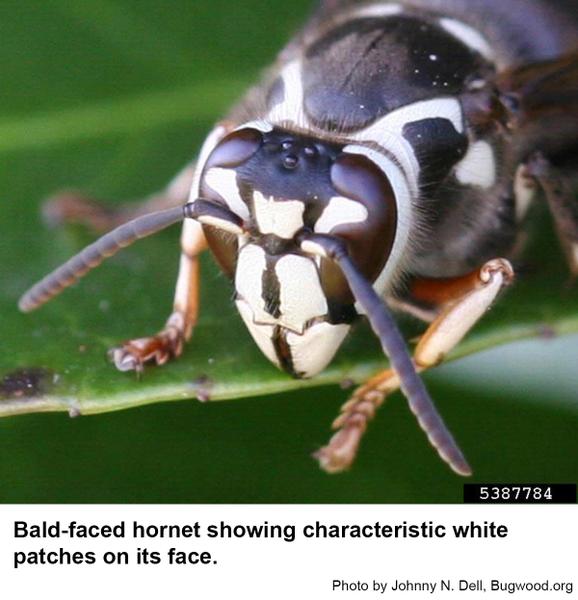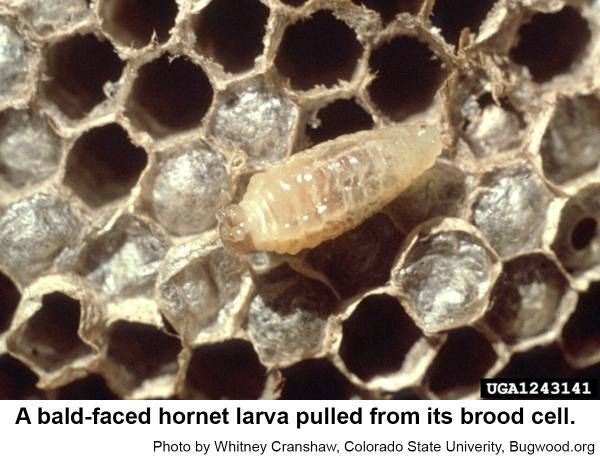Description and Biology
Baldfaced hornets, Dolichovespula maculata, are large wasps that build the large, gray cardboard nests in trees. The workers are black with white markings on the abdomen and on the face (hence the common name “bald-faced). They are called hornets because because of their large size and aerial nests. The workers catch caterpillars and other insects and carry them back to the nest to feed to the hornet larvae. All in all, baldfaced hornets are probably beneficial because they prey on plant pests. In the fall, males and overwintering queens are the last brood to be reared. After these reproductives leave the nest, social life sort of goes berserk and the workers do all sorts of strange things like throwing out the remaining larvae and building strange shapes on the nest. Frost ultimately kills the males and workers. Only the mated queens survive the winter in dry, sheltered situations to found new nests the following spring. To establish a nest, each queen has to forage for food, construct the paper brood cells, lay eggs, feed the first brood of worker grubs, and defend the nest from intruders until the first offspring emerge as adults. The new workers then assume all tasks except egg laying. The nest proper resembles layers of paper wasp nests stacked three or four deep all of which are surrounded by a carton several layers thick. The nest opening is usually on the side close to the bottom of the outer carton.
Host Plants
Baldfaced hornets sometimes cause damage to shrubs and trees with thin bark as the workers strip off the bark down to the cambium to chew up to build their nests. They also strip the silvery gray weathered outer layer of lumber for nest material. These wasps kill many insects that attack cultivated and ornamental plants. However, nests near homes may be a hazard. Baldfaced hornets can sting repeatedly and many workers swarm out of a nest aggressively when it is disturbed. The sting is instantly painful and the soreness, swelling and itching may persist for days. Some folks are exceedingly allergic to bee and wasp stings. Without prompt medical attention, people hypersensitive to stings may die as a result from a baldfaced hornet sting.
Residential Recommendations
Control of baldfaced hornets depends upon finding the nest. If you find a nest, the quickest way to find out if it is this year's nest with several hundred workers in it or if it is an empty nest from last year is to take a stout stick and rap upon the carton of the nest vigorously. After a very short while you should be able to hear or not a resonate buzzing sound as the workers drum on the carton inside and release their alarm pheromone by fanning the air to disperse it. Within a few seconds, alarmed workers will come boiling out of the nest ready to sting any moving creature. Because their stingers are not barbed, each worker can sting several times. Perhaps a better way to find out if the nest is occupied is to observe the opening at the bottom for a few minutes at a safe distance. On a sunny day, there will be some activity as the workers fly in and out.
Two kinds of chemicals can be used on the nest: wasp and bee freeze aerosols and Sevin dust. The wasp and bee freeze aerosols are a lot more fun but somewhat daunting in that the wasps will come boiling out of the nest in a frenzy to escape from the ether and petroleum distillates. Sevin dust should be applied at night when all the workers are safely in the nest. Using a duster, the Sevin should be blown into the nest entrance. As the workers leave and enter the nest the following day, they encounter the Sevin and track it into the nest, contaminating the larvae and each other. The colony usually dies out over the next few days although some individuals that were in pupal cocoons when the Sevin was applied may emerge later.
References
- Common name: yellowjackets and hornets, scientific name: Vespula and Dolichovespula spp. (Insecta: Hymenoptera: Vespidae). Grissell , E. E. and T. R. Fasulo. 2013 (revised). Featured Creatures, Entomology & Nematology. FDACS/DPI, EDIS, UF|IFAS. Publication Number: EENY-81.
- Controlling Baldfaced Hornets and Yellowjackets in and Around Structures. Waldvogel, M., P. Alder, and S. Bambara. 2018. Biting and Stinging Pests, NC State Extension Publications.
- Dolichovespula maculata. Kimsey, L. S. et al. 2021. North American Hornet Screening Tool.
- Yellowjackets of America North of Mexico. Akre, R. D. et al. 1980. USDA, Agriculture Handbook No. 552, 102 pp.
- Extension Plant Pathology Publications and Factsheets
- Horticultural Science Publications
- North Carolina Agricultural Chemicals Manual
For assistance with a specific problem, contact your local Cooperative Extension Center
This Factsheet has not been peer reviewed.
Publication date: April 8, 2016
Reviewed/Revised: June 22, 2021
Recommendations for the use of agricultural chemicals are included in this publication as a convenience to the reader. The use of brand names and any mention or listing of commercial products or services in this publication does not imply endorsement by NC State University or N.C. A&T State University nor discrimination against similar products or services not mentioned. Individuals who use agricultural chemicals are responsible for ensuring that the intended use complies with current regulations and conforms to the product label. Be sure to obtain current information about usage regulations and examine a current product label before applying any chemical. For assistance, contact your local N.C. Cooperative Extension county center.
N.C. Cooperative Extension prohibits discrimination and harassment regardless of age, color, disability, family and marital status, gender identity, national origin, political beliefs, race, religion, sex (including pregnancy), sexual orientation and veteran status.






